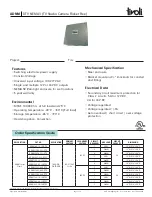
Page 1
INTRODUCTION
The Outside humidity transmitter uses a highly accurate and reliable Thermoset
Polymer based capacitance humidity sensor and state-of-the-art digital
linearization and temperature compensated circuitry in an weatherproof
enclosure to monitor outside humidity levels. Sensors are mounted in a sun and
wind shield for more accurate monitoring. An optional temperature sensor is
also available.
BEFORE INSTALLATION
Read these instructions carefully before installing and commissioning
the humidity transmitter. Failure to follow these instructions may result in
product damage. Do not use in an explosive or hazardous environment, with
combustible or flammable gases, as a safety or emergency stop device or in
any other application where failure of the product could result in personal
injury.
Take electrostatic discharge precautions during installation and
do not exceed the device ratings
.
MOUNTING
Select a suitable mounting spot on an exterior wall where the outside humidity transmitter is best protected from direct exposure to sunlight,
wind, etc. preferably on a North facing wall. Do not mount the sensor near opening
windows, supply/exhaust air louvres or other known air disturbances. Avoid areas
where the sensor is exposed to vibrations or rapid temperature changes.
The sensor is provided with either a connection hole for 1/2" Conduit or a cable gland
fitting. When using conduit, run a length of conduit through exterior wall and seal. Use
14-22 AWG shielded wiring for all connections and do not locate the device wires in
the same conduit with wiring used to supply inductive loads such as motors. Make all
connections in accordance with national and local codes.
The sensor installs directly on an exterior wall using the two integrated mounting holes
provided on the enclosure. Select the best mounting technique based on the exterior
wall material. The two mounting holes will facilitate a #10 size screw (not supplied). The
sensor fitting must be pointing down. See Figure 1.
The enclosure has a hinged cover with a latch. Open the cover by pulling slightly on
the latch on the right side of the enclosure, at the same time pulling on the cover, as
illustrated in Figure 2.
When using conduit, feed conduit through the provided hole in the back of the
enclosure and secure with a lock nut as shown in Figure 3. It is recommended that
weatherproof conduit be used. If using a cable gland connection, feed wiring though
the cable gland on the top of enclosure and tighten as shown in Figure 4.
Make wiring connections as per the “Wiring” illustrations on Page 2.
Swing door closed until securely latched. For added security, 2 screws are provided
that may be installed in the integrated screw tabs. See Figure 5.
1/2" Conduit
Connection
Conduit Connection
Optional Cable Gland Fitting
Figure 2
Figure 3
Figure 4
Figure 5
Figure 1
IN-GE-HSOBXXX-03
Copyright © Greystone Energy Systems, Inc. All Rights Reserved Phone: +1 506 853 3057 Web: www.greystoneenergy.com
Outside Humidity Transmitter
HSOB Series - Installation Instructions




















